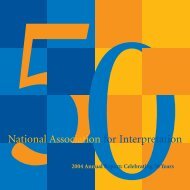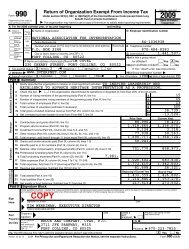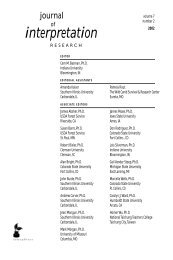Certification
Certification Study Guide - National Association for Interpretation
Certification Study Guide - National Association for Interpretation
You also want an ePaper? Increase the reach of your titles
YUMPU automatically turns print PDFs into web optimized ePapers that Google loves.
1<br />
NAI’s<br />
<strong>Certification</strong><br />
Program<br />
History<br />
Long before the National Association for Interpretation came into existence in 1988,<br />
individuals who practiced interpretation as a profession began to look at certfication<br />
as a way of recognizing that a certain level of proficiency in the art and science of<br />
interpretation had been attained.<br />
For over two decades, the issue of certification was hotly debated. Some<br />
individuals felt that only those with a college education could consider<br />
themselves “professional interpreters,” while others felt that natural storytellers<br />
with little or no training, but years of experience relating to visitors in an<br />
interpretive setting should also be recognized.<br />
Today’s certification program, initiated in 1998, has evolved from years of<br />
discussion and the efforts of numerous committees formed to study the issue<br />
from all sides.<br />
It recognizes that individuals who are committed to interpretation as their<br />
profession may come to that calling in a number of ways and with a number of<br />
different skill sets.<br />
The certification program is designed to exclude no one who recognizes that<br />
interpretation is a profession with its own body of knowledge, principles, and<br />
ongoing research, regardless of how they came to be in the field or how their job<br />
relates to interpretation.<br />
The program also recognizes that there are different skill sets required for different<br />
jobs within the field of interpretation and that not everyone who begins as a frontline<br />
interpreter will want to move into other types of work, such as management of<br />
interpretive sites, planning, or training.<br />
Therefore, the program currently sustains six categories that recognize six<br />
different skill sets. These categories were selected after careful consideration of<br />
the types of individuals that make up NAI’s membership and the jobs that they<br />
hold. Categories were not developed for complementary disciplines for which<br />
other certification programs already exist (for example, exhibit designers could<br />
choose to become Certified Heritage Interpreters, but their design skills can be<br />
certified through the Industrial Design Society of America).<br />
4












